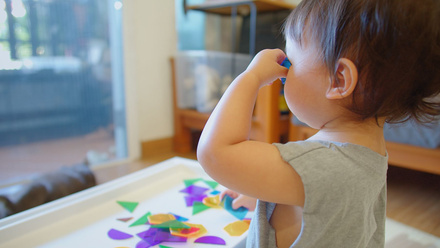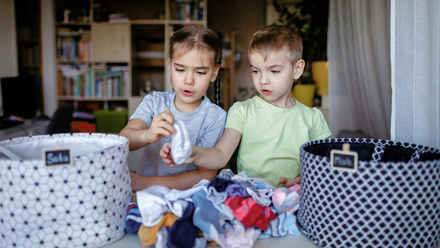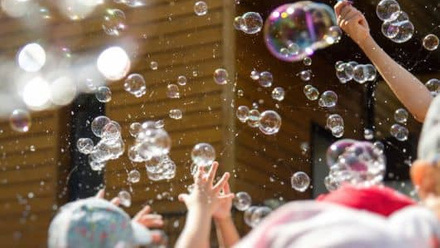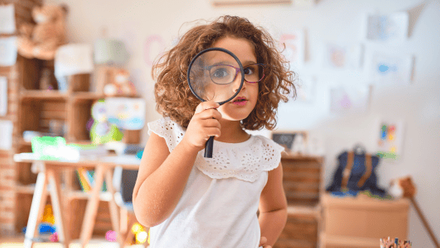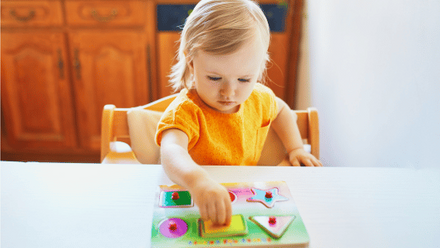How to make early maths part of everyday life
Early maths skills are key to a child’s wider understanding of the world around them, as they learn to experiment in, and beyond, their environment. But early maths skills are so much more than recognising numbers and counting to 10! We use mathematical thinking in so many ways: through our problem-solving, spatial awareness and colour identification.
In this learning workout, we are going to explore ways in which we can use early maths outside of structured plans and implement this kind of learning in everyday activity.
What is early maths?
Mathematical understanding starts with a child’s innate curiosity and natural ability to explore new things: from a six-month-old’s ability to investigate different weights, to a three-year-old child squeezing into a cardboard box rocket, mathematical concepts are all around us and begin long before we start even thinking about numbers themselves.
Every opportunity to explore is a new chance to develop mathematical learning and this happens both in and outside of provision. Because the topic of ‘early maths’ is so broad, the possibilities are infinite as to what we can do to develop meaningful opportunities for even more maths!
Research suggests that that using effective approaches to early numeracy skills development can increase children’s learning by seven months so it’s important that we incorporate lots of mathematical thinking into our day. Whilst it is great to have structured activities and continuous provisions planned that aim to develop early maths skills, a lot of our everyday interactions can offer valuable opportunities, not only to develop mathematical knowledge but to apply learning to real life.
Putting it into practice
Let’s think about some of the simple ways you can integrate mathematical moments into your typical day…
Exploring Space!
Spatial reasoning relates to how we interpret things in our environment and understand perspective. It is key to our conceptual understanding of size and matter and is something children are naturally inquisitive about from a very young age.
Ideas for everyday use with children from birth to age three:
- Allow babies to explore cupboards and empty boxes that they can physically peer inside and sit amongst. This helps not only with their physical development, but also to understand their positioning ‘inside’ and ‘outside’ of objects.
- Bathtime can be such fun and it’s about to get even better! Using a variety of everyday containers, your bathtime fun can become a beautiful learning opportunity to explore filling and pouring, investigating shape and weight.
Ideas for everyday use with three-to five-year-olds:
- Spatial reasoning also encompasses a sense of place and direction. Narrating directions when driving home or exploring the supermarket can be a great way for children to listen and interpret directions meaningfully within their sense of the space.
Patterns
We use patterns every day to help us with simple tasks and sometimes they even become second nature to our routine tasks. Understanding patterns and making predictions are key to our wider mathematical knowledge and practical application of some pretty tricky concepts…
Ideas for everyday use with children from birth to age three:
- Recognising patterns are also key to developing a breadth of mathematical concepts and can be initiated at a young age through activities commonly associated with social skills. Everyday examples of pattern formation can include turn-taking with others through any means. Highlighting the pattern and asking children to predict what happens next is a great way to get them familiar with thinking about patterns and rhythms in their routine.
Ideas for everyday use with three-to five-year-olds:
- Matching activities are a fun and versatile way to introduce many aspects of maths pedagogy into your daily routine. Giving children a sense of responsibility by asking them to pair up socks in the laundry pile, or laying the table for dinner allows them to develop skills of comparison and recognition of colour and pattern along with a helping hand around the house!
Numbers
Of course, using numbers, identifying symbols and recognising order are a key part of thinking mathematically. But, it’s not just a case of being able to count to 20; using ordinal numbers (e.g. 1st, 2nd, 3rd) and matching amounts to numerals require a different development of our number knowledge, too.
Ideas for everyday use with children from birth to age three:
- Just as we talk to children to develop their communication and language skills, we can do the same for mathematical language. Narrating a walk up the stairs by counting as you climb can be one useful way to implement familiarity with cardinal numbers (counting numbers that start from 1 and go up) and, before you know it, they’ll be counting for you!
Ideas for everyday use with three-to five-year-olds:
- Recognising numerals and how they are used in everyday practice can be a big concept to get your head around when you’re three. When out and about, utilise road signs, shop fronts and car registrations to think about how numbers are used all around us, creating your very own number hunt.
Takeaways for early maths
Mathematical understanding is not just about numbers! Developing a broad and early understanding of maths helps children make sense of their wider world, develop social interactions and communicate with others.
We know that parental engagement and home learning environments are key to supporting children’s learning and development and using everyday interactions like those suggested above are just some of the fun and accessible ways we can support children to know that their maths matters!
Why not have a look at our member resources for more mathematical inspiration? Looking for more? Explore the Maths Champions programme with NDNA today!


